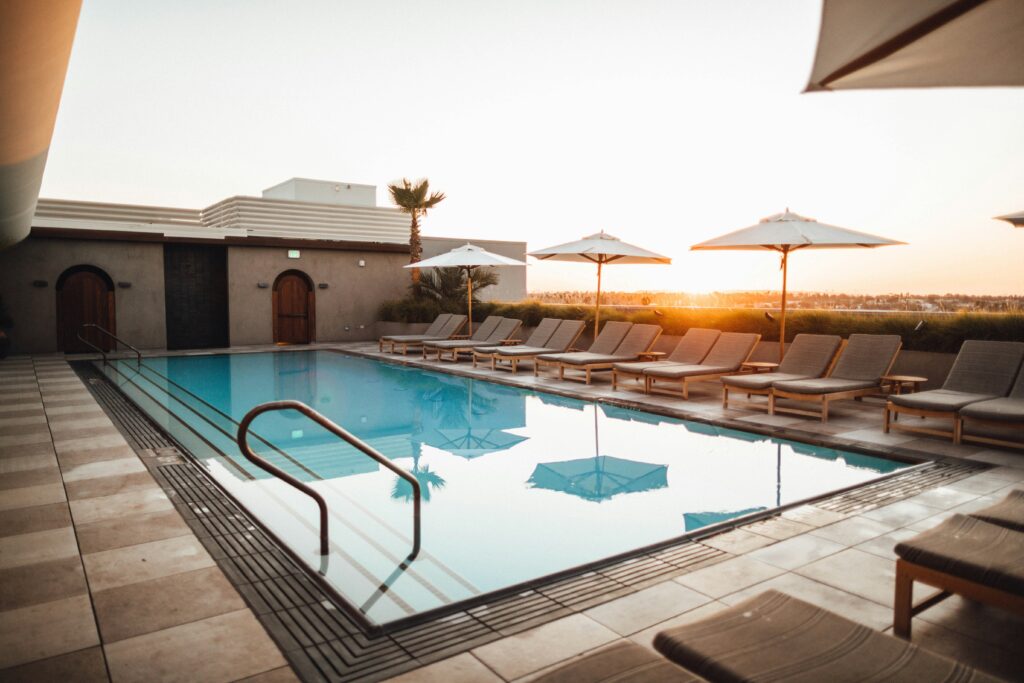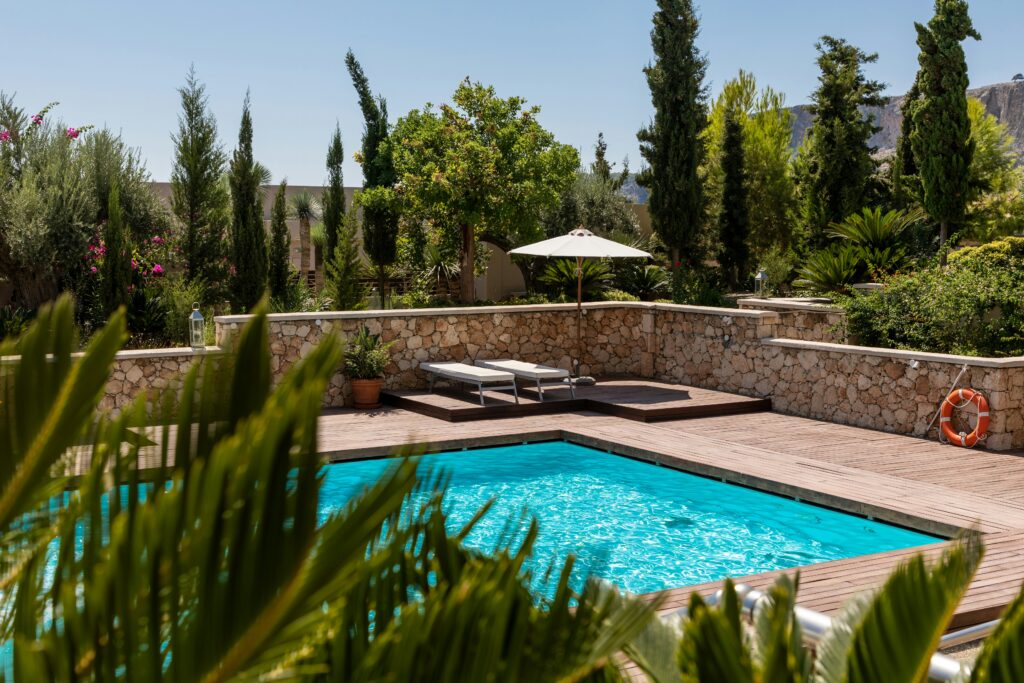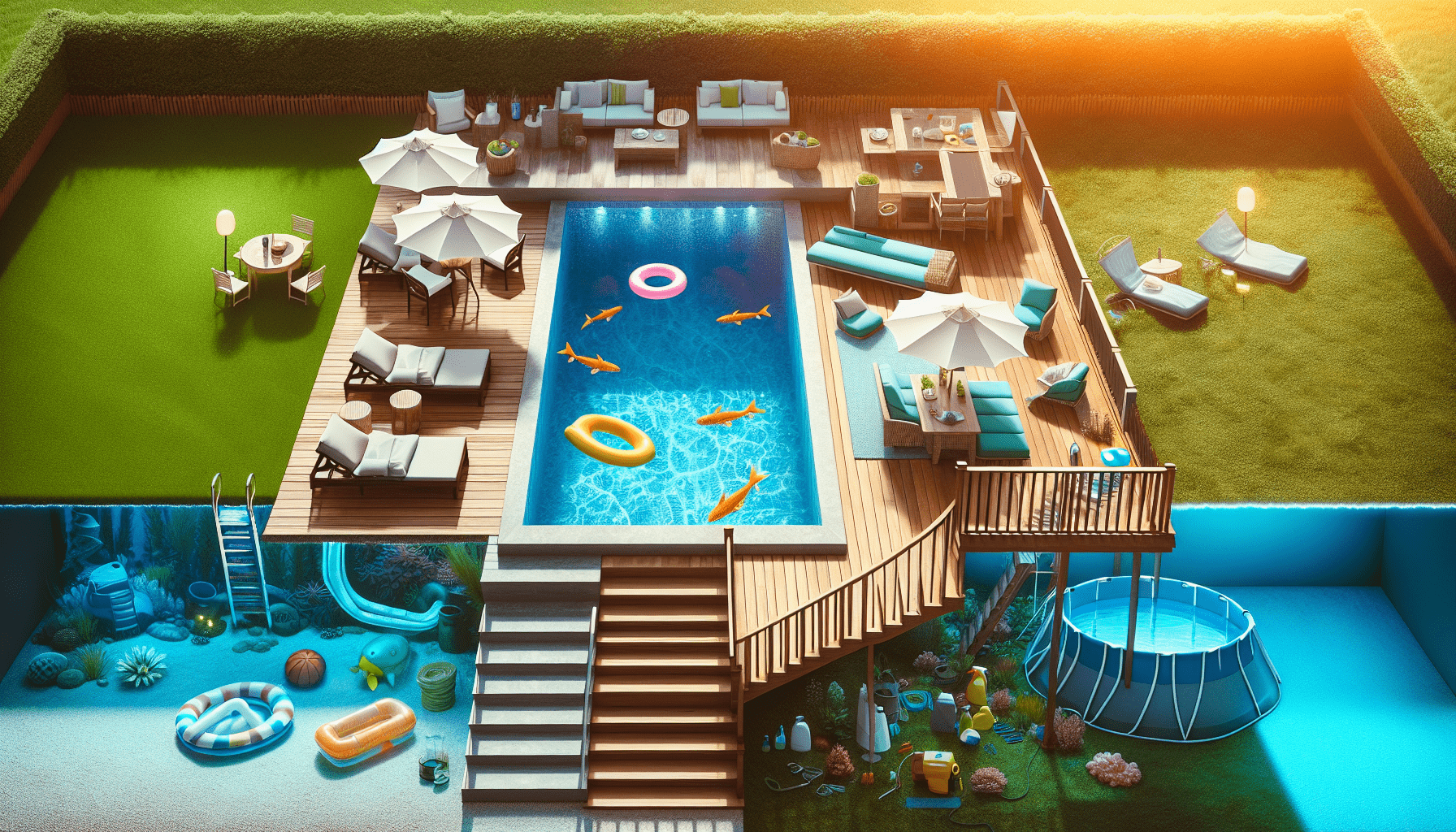Are you ready to take the plunge and invest in your very own swimming pool? The decision between an inground or above ground pool can be a tough one to make, as each option offers its own set of advantages and considerations. In this article, we will explore the factors that come into play when choosing the perfect swimming pool, such as space availability and budget, so you can make an informed decision that will bring years of enjoyment to you and your family.
Cost
Initial Cost
When considering the cost of a swimming pool, the initial cost is an important factor to consider. Inground pools tend to have a higher initial cost compared to above ground pools. This is because inground pools require excavation, construction, and landscaping. On the other hand, above ground pools are typically more affordable as they come in prefabricated kits, which require less labor and materials.
Installation Cost
The cost of installation is another key aspect to consider. Inground pools often require professional installation due to the complexity of the excavation and construction process. This can add to the overall cost of the pool. On the other hand, above ground pools are generally easier to install and can often be done as a DIY project, resulting in lower installation costs.
Maintenance Cost
When evaluating the cost of a swimming pool, it is important to consider the maintenance expenses. Both inground and above ground pools require regular maintenance to keep them clean and safe. However, it is important to note that inground pools often require more maintenance due to their larger size and additional features. This can include more frequent cleaning, regular chemical balancing, and equipment upkeep, all of which can add to the overall maintenance cost.
Long-term Cost
Looking at the long-term cost of owning a swimming pool is crucial in making an informed decision. Inground pools are generally seen as a long-term investment that can increase the value of your property. They are known for their durability and can last for several decades with proper maintenance. On the other hand, above ground pools may have a shorter lifespan and may require replacement sooner, adding to the long-term cost. Additionally, the cost of annual operating expenses, such as heating and electricity, should also be considered when evaluating the long-term cost of a swimming pool.
Design and Aesthetics
Customization Options
One of the advantages of an inground pool is the wide range of customization options available. From various shapes and sizes to different depths and features, inground pools provide the opportunity to create a personalized swimming experience. Above ground pools, on the other hand, have more limited customization options due to their prefabricated nature.
Integration with Surroundings
The design and aesthetics of a swimming pool can greatly impact the overall look and feel of your outdoor space. Inground pools can be seamlessly integrated with your surroundings through landscaping and decking options, resulting in a cohesive and visually appealing backyard. Above ground pools, while less customizable in terms of integration, can still be enhanced with landscaping and deck designs, providing a visually appealing addition to your outdoor space.
Visual Appeal
Both inground and above ground pools can contribute to the visual appeal of your backyard, but they offer different aesthetics. Inground pools often have a more sophisticated and elegant appearance, blending seamlessly into the landscape. On the other hand, above ground pools can have a more playful and relaxed vibe, adding a touch of fun to your outdoor space. The choice between the two aesthetic styles ultimately depends on your personal preferences and the overall design of your backyard.
Durability
Material
The choice of material for your swimming pool plays a significant role in its durability. Inground pools are commonly constructed using concrete, fiberglass, or vinyl. Concrete pools are known for their longevity and durability, while fiberglass pools offer excellent resistance to cracks and stains. Vinyl pools are generally more affordable, but they may require liner replacement over time. Above ground pools are typically made of materials such as steel, aluminum, or resin. Steel is known for its strength and durability, while aluminum and resin offer rust and corrosion resistance, making them ideal for outdoor use.
Wear and Tear
The durability of a swimming pool is also influenced by the wear and tear it may encounter over time. Inground pools, due to their permanent nature, are more resistant to wear and tear caused by environmental factors such as weather conditions and aging. Above ground pools, while durable, may be more susceptible to damage from external factors such as strong winds or heavy rainfall. Regular maintenance and proper care can help minimize wear and tear and extend the lifespan of any pool.
Lifetime
The lifespan of a swimming pool is an important consideration when evaluating its durability. Inground pools are built to last for several decades and can withstand the test of time with proper maintenance. This long lifespan makes them a desirable option for those looking for a permanent and durable swimming pool. Above ground pools, while they may have a shorter lifespan compared to inground pools, can still provide many years of enjoyment if well maintained. The choice between the two largely depends on the desired longevity of the pool and your budget.
Installation
Process
The installation process of a swimming pool differs between inground and above ground options. Inground pool installation involves several steps, including excavation, construction, plumbing, and electrical work. This process requires skilled professionals and can be time-consuming. On the other hand, above ground pool installation is generally quicker and simpler. Most above ground pools come in prefabricated kits that can be easily assembled according to the manufacturer’s instructions. This makes them a more straightforward option for those seeking a shorter installation process.
Timeframe
The timeframe for installing a swimming pool can vary depending on the type and size of the pool, as well as other factors such as weather conditions and permit approvals. Inground pool installation typically takes longer due to the involved construction process, which can range from a few weeks to several months. Above ground pool installation, on the other hand, can often be completed within a few days or weeks. It is important to consider your timeline and any specific events or occasions when choosing the type of pool that best suits your needs.
Level of Expertise Required
Inground pool installation requires a high level of expertise due to the complexity of the process. It often involves coordination between various professionals, such as excavation teams, builders, plumbers, and electricians. Hiring experienced contractors or pool builders is essential to ensure a successful installation. In contrast, above ground pool installation can be done by homeowners themselves with the help of a few friends or family members. The level of expertise required for above ground pool installation is generally lower, making it a viable option for those with some DIY skills.

Space and Size
Available Space
One of the primary considerations when choosing a swimming pool is the available space in your backyard. Inground pools require more space as they are larger and often come with additional features such as decks and landscaping. If you have a spacious backyard, an inground pool can be a great option as it allows for more design flexibility and offers a grander swimming experience. However, if you have limited space, an above ground pool can be a practical solution as it requires less area and can fit into smaller yards or even be installed partially in the ground.
Size Options
Both inground and above ground pools offer a range of size options to suit different preferences and space limitations. Inground pools can be custom-built to any desired size, allowing for a tailored swimming experience. From smaller plunge pools to larger lap pools, the size options for inground pools are virtually limitless. Above ground pools also come in various sizes, with options ranging from compact models suitable for smaller yards to more spacious ones that can accommodate larger groups. Determining the ideal pool size depends on the available space, the intended use, and the number of people expected to use the pool.
Flexibility
The flexibility of a swimming pool is an important aspect to consider, especially if you anticipate changes in your needs or lifestyle. Inground pools, once installed, are permanent structures and offer less flexibility in terms of relocation or modifications. Above ground pools, on the other hand, are more portable and can be disassembled, relocated, or even upgraded to a different model in the future. This flexibility makes above ground pools a good choice for those who may need to adapt their pool setup due to changes in their living situation or preferences.
Safety
Access Points
Ensuring the safety of your swimming pool is paramount, especially if you have young children or pets. Inground pools typically have more options for safety features, such as secure gates, self-latching doors, and perimeter fencing. These precautions help restrict access to the pool, reducing the risk of accidents. Above ground pools can also be made safe by installing similar features, such as locking gates, fences, and alarms. Safety covers and pool nets are additional options that can provide an extra layer of protection for both inground and above ground pools.
Fencing and Barriers
Adding physical barriers around your swimming pool can help prevent unauthorized access and increase safety levels. Inground pools often require fencing as per local regulations to ensure compliance with safety standards. These fences can be customized to match your landscaping and design preferences while effectively securing the pool area. Above ground pools may also benefit from the installation of fencing or barriers, especially if local regulations require them. It is important to consider the safety aspects and regulations of your specific area when deciding on the type of pool and the necessary safety measures.
Child-friendly Features
Pools can be made more child-friendly by incorporating features that enhance safety and cater to the needs of young swimmers. Inground pools can include shallow areas or steps to provide a safe space for children to play and stay at a comfortable depth. Additionally, automatic pool covers can be installed to prevent accidental falls or submersion. Above ground pools can be made child-friendly by adding ladder safety features, such as removable steps or locking gates, to prevent unsupervised access. It is essential to prioritize the safety of children when choosing a swimming pool and to implement appropriate safety measures.

Maintenance
Cleaning
Regular cleaning is a crucial aspect of pool maintenance to ensure a clean and inviting swimming environment. Inground and above ground pools require similar cleaning routines, including skimming the surface, vacuuming the pool floor, and brushing the walls. The frequency of cleaning depends on factors such as usage, weather conditions, and pool features. In both cases, investing in pool cleaning equipment, such as skimmers, brushes, and vacuum systems, can make maintenance tasks easier and more efficient. Following a consistent cleaning regimen will help keep your pool sparkling clean and ready for use.
Chemical Balancing
Maintaining proper chemical balance is essential to keep your pool water safe and clear. Chemical balancing involves regulating the pH level, sanitizing the water with chlorine or alternative disinfectants, and regularly testing the water quality. Inground and above ground pools require similar chemical balancing practices, including adding chemicals, such as chlorine tablets or granules, as needed. Automatic chlorinators or saltwater systems can also be installed to simplify the chemical maintenance process. It is important to regularly monitor the water chemistry and make necessary adjustments to ensure a healthy swimming environment.
Equipment Upkeep
To ensure the longevity and optimal performance of your swimming pool, regular equipment upkeep is necessary. This includes maintaining and servicing pool equipment such as pumps, filters, heaters, and automated control systems. Inground pools often have more complex equipment setups, requiring more involved maintenance. Above ground pools usually have simpler equipment configurations, making upkeep more straightforward. Taking the time to clean, inspect, and repair or replace any faulty equipment will help extend its lifespan and prevent any potential issues that may arise.
Usage and Purpose
Recreational Swimming
One of the primary purposes of a swimming pool is recreational swimming. Whether it’s for cooling off on hot summer days or relaxing and unwinding after a long day, both inground and above ground pools offer opportunities for enjoyable recreational swimming. Inground pools generally provide a more luxurious and spacious swimming experience, making them ideal for hosting pool parties or gathering with friends and family. Above ground pools, while smaller in size, still provide ample space for recreational swimming and can create a lively and fun atmosphere in your backyard.
Exercise and Fitness
Swimming is known for its numerous health benefits and is often incorporated into exercise and fitness routines. Inground pools are well-suited for those looking to swim laps or engage in water aerobics due to their larger size and depth options. The length and depth of inground pools allow for a more effective and versatile workout. Above ground pools, while more compact, can still cater to exercise and fitness needs by incorporating optional features such as swim jets or resistance systems. The choice between the two largely depends on the specific exercise preferences and space limitations.
Entertaining Guests
A swimming pool can serve as an excellent venue for entertaining guests and creating memorable experiences. Inground pools, with their customizable designs and spacious layouts, offer the perfect setting for hosting social gatherings or backyard parties. The addition of features such as waterfalls, poolside seating, or outdoor kitchens can further enhance the entertainment value of an inground pool. Above ground pools, while smaller in size, can still provide a fun and inviting atmosphere for hosting friends and family, creating a cozy gathering place that encourages interaction and relaxation.

Climate and Seasons
Temperature Range
The climate in which you reside plays a significant role in determining the swimming season and temperature range of your pool. Inground pools, being larger and typically offered in a greater variety of depths, can be better equipped for accommodating different temperature preferences. They can be heated for more comfortable swimming in colder climates and may also offer the option of pool covers to help retain heat. Above ground pools, while they can also be heated, may have more limited options for maintaining warmer water due to their smaller size and shallower depths. Consider your local climate and preferences for water temperature when selecting a pool type.
Winterization
Proper winterization is crucial for extending the lifespan of your swimming pool and preserving its functionality during colder months. Inground pools often require more involved winterization procedures due to their size and complexity. This may involve draining the pool, adding winterizing chemicals, and covering or securing the pool to protect it from harsh weather conditions. Above ground pools, while typically easier to winterize, still require similar steps to prepare them for the winter season. The ease of winterization should be considered when choosing a pool, especially if you live in an area with harsh winters.
Year-round Use
The ability to use the swimming pool year-round is a significant consideration for those living in climates with mild or moderate temperatures. In these regions, inground pools may offer the advantage of being usable throughout the year due to their larger size and the option to heat the water. This allows for year-round enjoyment and makes the pool a valuable investment. However, above ground pools can also be used year-round if they are appropriately heated and have the necessary access to power and utilities. The decision on year-round use depends on your climate, personal preferences, and willingness to invest in heating systems.
Resale Value
Investment Return
When choosing a swimming pool, it is essential to consider its potential impact on the resale value of your property. Inground pools are often regarded as a desirable feature that can increase the overall value of a home. Many homebuyers are willing to pay a premium for properties that have well-maintained inground pools, especially in regions with favorable climates. While above ground pools may not contribute as significantly to the resale value, they can still enhance the appeal of a property and potentially attract certain buyers. Careful consideration should be given to the potential return on investment when deciding between the two options.
Relevance to Potential Buyers
The relevance of your swimming pool to potential buyers is another important aspect to consider if you plan on selling your property in the future. Inground pools are often seen as a luxurious feature that appeals to buyers looking for a high-end and upscale lifestyle. The customization options, aesthetics, and long-term durability associated with inground pools can make them more attractive to potential buyers. Above ground pools, while they may not have the same level of prestige, can still be appealing to buyers looking for a more affordable and easily maintainable swimming option. Understanding the preferences of potential buyers in your market is crucial in determining the relevance of your pool choice.
In conclusion, choosing the perfect swimming pool requires careful consideration of various factors. The initial cost, installation cost, and long-term cost must align with your budget and financial goals. Design and aesthetics play a role in creating your desired backyard oasis, and the customization options and integration with the surroundings should match your personal style. Durability, determined by materials and lifespan, ensures that your investment lasts. Installation process, timeframe, and level of expertise required should align with your preferences and capabilities. Available space, size options, and flexibility determine how the pool fits into your backyard. Safety features and maintenance requirements ensure the pool remains a secure and enjoyable space. Lastly, considering the pool’s purpose, climate, and resale value will help determine the best swimming pool option for your specific needs. With these considerations in mind, you can confidently choose a swimming pool that provides years of enjoyment and enhances your outdoor living experience.

